
Biomedical EPR Part-B Methodology Instrumentation and Dynamics - Sandra R. Eaton
.pdf242 |
JACK H. FREED |
At Cornell we quantitatively tested the ENDOR theory on several semiquinones, (Leniart et al, 1975). We showed that aside from explaining the ENDOR enhancements in terms of the spin-relaxation processes and molecular dynamics, a very important feature was the observed linewidths for the NMR transitions of the free radicals. They very nicely complement the information obtained from the ESR linewidths. This is most important for the case of concentration-dependent linewidths. The sources are Heisenberg spin exchange and electron-electron dipolar interactions between colliding radicals. Their very similar effects on ESR linewidths make it very difficult to separate them out, but it is important to do so in order to utilize these interactions to study microscopic molecular diffusion in liquids. However, these two mechanisms have very different relative effects on the NMR vs. the ESR linewidths, so we were able to successfully separate them from our ENDOR studies.
Jim Hyde and I collaborated on aspects of ENDOR. However, our most important collaboration was undoubtedly the development of ELDOR (electron-electron double resonance) in liquids, (Hyde et al, 1968). This came about during a visit to Varian in the spring of 1967, when Jim showed me the very exciting ELDOR spectra he and Jimmy Chien had obtained with a bimodal cavity that Jim had developed. Using the saturation and double resonance theory that I had developed, I could come up with the appropriate theory for the ELDOR experiment. ELDOR, today, has taken on many new configurations, but in all of them it serves as a powerful means of studying spin-relaxation for purposes of exploring both rotational and translational motions in liquids.
3.SLOW MOTIONAL ESR AND MOLECULAR DYNAMICS
With the theory of ESR linewidths, spin relaxation, saturation, and double resonance well-established by the mid to late 1960’s, it could have appeared that all that remained was to apply it to a wide variety of experiments to study molecular dynamics. However, I personally was concerned with some of the theoretical foundations of Wangness-Bloch- Redfield and Kubo-Tomita theory. It appeared to work so well in the motional narrowing region, but it was essentially a perturbation theory, which was ill-defined in the sense that one kept the first non-trivial term in a perturbation expansion, yet there was no way of generating the higher order terms in the expansion. The question remained how to extend Redfield theory to all orders in a systematic fashion as motional rates slow. Using Kubo’s method of generalized cumulant expansions in the methodology of

ESR AND MOLECULAR DYNAMICS |
243 |
statistical mechanics, (Kubo, 1962, 1963), I was able to provide a formal, general solution. Ordinary cumulant expansions arise in probability theory when one examines statistical averages of exponential functions. Spin relaxation, however, involves ensemble averages of exponentiated spin Hamiltonian super-operators, so one must generalize the conventional probability techniques. Thus, it proved possible to utilize Kubo’s generalized cumulant method to develop general theorems about spin-relaxation. For example, one could in principle, calculate the relaxation matrix to all orders
in perturbation theory, and I could show that the |
order term involved a |
|
particular form of the |
order time correlation function of the molecular |
|
motion treated as a random function. Relaxation theory is a long-time limiting theory, but the generalized cumulant method even allowed one to get the finite time corrections. This yielded a general formulation of relaxation theory valid to all orders, (Freed, 1968). Redfield theory provides just the leading or  order term. However, generalized cumulant expansions suffer very severely from the problems of perturbation expansions, viz. each higher order term is much harder to compute than the previous term.
order term. However, generalized cumulant expansions suffer very severely from the problems of perturbation expansions, viz. each higher order term is much harder to compute than the previous term.
The slow motional ESR problem becomes important when one studies spin-labeled macromolecules, as McConnell was doing at that time. Other efforts on this problem, included that of Kivelson, who had another method that also supplied perturbative corrections to Redfield theory, (Sillescu and Kivelson, 1968), as well as the early work of Korst and Khazanovitch (1964), who had solved the slow-motional problem for the simple case of only a secular perturbation, i.e. a perturbation term in the spin-Hamiltonian that commutes with the main term. With all its complexities, at least the generalized cumulant theory was appropriate for all types of perturbation and all types of motions.
In 1969, I spent a sabbatic with Kubo in Tokyo. He called my attention to two of his papers, wherein he had congealed, in a largely heuristic sense, his ideas on stochastic Liouville equations, (Kubo, 1969a,b). I realized how I could incorporate an approach based on the stochastic Liouville equation (SLE) to develop a complete analysis of the ESR slow-motional problem. In order to use the SLE one had to assume that the motional dynamics could be described statistically by a Markov process. More serious in practical terms was the need to take the matrix representations of the SLE and solve for the ESR spectrum on a computer, which could not be done in Tokyo at that time and had to be done at Cornell. The theory was worked out for all relevant cases of g-tensor and hyperfine anisotropy, and it was extended to include saturation phenomena, (Freed et al, 1971a).
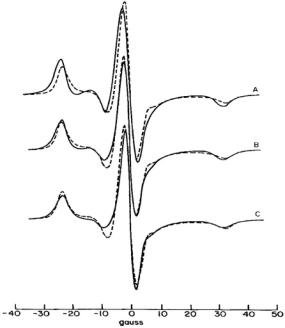
244 |
JACK H. FREED |
Figure 2. Slow motional ESR spectrum from peroxylamine disulfonate anion in frozen  at T = -60°C. The dashed line is the experimental spectrum, and the solid lines are calculated for a particular microscopic model of rotational reorientation but with differing anisotropy of the rotational diffusion tensor: A) isotropic; B) moderate anisotropy; C) larger anisotropy. From Goldman et al (1972).
at T = -60°C. The dashed line is the experimental spectrum, and the solid lines are calculated for a particular microscopic model of rotational reorientation but with differing anisotropy of the rotational diffusion tensor: A) isotropic; B) moderate anisotropy; C) larger anisotropy. From Goldman et al (1972).
At Cornell, we successfully completed experiments using peroxylaminedisulfonate (PADS) in ice. These gave lovely slow-motional spectra with none of the inhomogeneous broadening of typical spin-labels (see Fig. 2). An important discovery was that we could fit these spectra significantly better if we assumed jump-type reorientations rather than simple Brownian motion, (Goldman et al, 1972). Thus, the slow motional spectra were proving to be more sensitive to the microscopic molecular dynamics than are the fast motional spectra. It was also possible to extend the SLE approach to a complete solution of slow-tumbling triplets, (Freed et al, 1971b) generalizing earlier work of Norris and Weissman (1969). In addition both Gordon and Lynden-Bell made early contributions to the slow motional problem, (Gordon and Messenger, 1972).
Work continued on slow-motional ESR through the 1970’s utilizing the spectra to obtain new insights into molecular rotational motions in ordinary isotropic fluids, in liquid crystals, and in model membranes, (Hwang et al, 1975; Polnaszek and Freed, 1975). The SLE approach was also utilized to
ESR AND MOLECULAR DYNAMICS |
245 |
provide a quantitative theory for the then new phenomena of chemicallyinduced dynamic spin polarization: CIDEP and CIDNP (Freed and Pederson, 1976). The great challenge was in carrying out the rather tedious slowmotional simulations.
Also, in that period, Dalton and Robinson, (Hyde and Dalton, 1979; Beth and Robinson, 1989) managed to employ the SLE to provide a theory for Hyde’s new saturation transfer technique, which is useful for studying very slow motions.
During that period it was also possible to improve on the formulation of the SLE, to study more thoroughly its range of validity, and to extend its range of applicability. Nevertheless, these initial efforts have successfully withstood the tests of time. Clearly, the most important accomplishment was the development in the 1980’s of a very efficient method of computing solutions to the SLE that drastically reduced the computation time and storage requirements and ultimately led to versions that could be made generally available, (Moro and Freed, 1981).
Working with Giorgio Moro, we uncovered material about the Method of Moments. This is a formal procedure for projecting out a sub-space, known as a Krylov space, starting from a real symmetric or Hermitian matrix and an initial vector, each of dimension n. This sub-space will, in general, be of dimension m lower than n (i.e. m < n), and in the representation of the basis vectors obtained, the m-dimensional approximation to the original matrix will be in tridiagonal form. The practical implementation for computation involved a specific algorithm, known as the Lanczos Algorithm (LA), which, however was known to suffer badly from computer round-off error. Another problem confronted us in that the LA had been developed for realsymmetric or Hermitian matrices, but not for the complex symmetric matrices (which are non-Hermitian) that one generates with the SLE. The available theorems no longer necessarily applied, including a guarantee that the matrix is diagonalizable. We were not especially troubled by the latter fact, since we could diagonalize SLE matrices by standard, but slow, methods. However, the complex symmetric arithmetic could (and does) increase the problem of computer round-off error.
Despite these concerns, we found the LA succeeded admirably for numerically solving the SLE, (Moro and Freed, 1981). It reduced computation time by at least an order of magnitude, and it also greatly reduced storage requirements. Why does the LA work so well? First of all, it takes full advantage of the sparsity of the SLE matrix. Secondly, after just a few Lanczos projections it produces a sub-space that very effectively includes what is important for the ESR experiments. This is partly because the initial vector is a kind of statement of the physics of the ESR experiment. It essentially represents the ESR transition moments. Thirdly, the ESR
246 JACK H. FREED
experiment is dominated by the slowly decaying eigenvalues of the SLE, and these are accurately obtained from the small sub-space approximation. But what about the eigenvalues that are poorly represented? They are automatically projected out of the solution when one calculates the specific ESR observable, viz. the lineshape. And what about the round-off error? Since we only need a small sub-space generated by a relatively small number of Lanczos projections, the calculation is terminated before the round-off error becomes serious. Important for the execution of these programs, (Schneider and Freed 1989a) are very powerful methods we developed for selecting the minimum basis set to represent the SLE, and for reliably determining when sufficient Lanczos projections have been utilized, (Schneider and Freed, 1989b).
Thus the Lanczos algorithm provides both a conceptually insightful approach as well as an extremely powerful computational algorithm for the SLE. It has since been possible to show the connection of the LA with other mathematical methodologies, but none other lends itself so effectively to a computational algorithm, (Schneider and Freed, 1989b). The most instructive connection is that to the Mori method, well-known in statistical mechanics.
4.HIGH FIELD ESR AND MOLECULAR DYNAMICS
With the advent of high field far-infrared (FIR) ESR, with its enhanced resolution to motional dynamics, we have found it desirable to use enhanced models for molecular reorientation to fit these spectra. We can now dispense with the old and worn jump models of diffusion. Instead we approximate the many-body problem of dealing with the microscopic details of the fluid by a set of collective degrees of freedom that represent the main effects of the solvent on a rotating solute. These collective variables are taken as a loose solvent “cage” that is slowly relaxing. The solute is then reorienting more rapidly in this cage. This is called the slowly relaxing local structure (SRLS) model. Since we approximate the combined system of solute plus cage by Markovian equations, the SLE remains valid in this augmented form. Then the Lanczos projections effectively determine the extent to which the cage variables are needed to interpret the ESR spectrum, (Polimeno and Freed, 1995).
In addition to the greater sensitivity of FIR-ESR (e.g. 250 GHz) to the details of the molecular motions in fluids, another virtue of FIR-ESR (e.g. 250 GHz) over ESR at conventional microwave frequencies is the excellent orientational resolution it provides for studies utilizing nitroxide spin labels
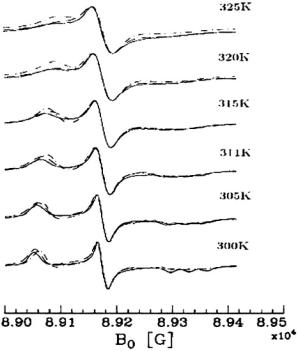
ESR AND MOLECULAR DYNAMICS |
247 |
(Budil et al, 1989; Earle et al, 1993, 1997, 1998). As a result, at 250 GHz, once motion is discernible in the spectrum, one can discern about which axis (or axes) the motion occurs, (Earle et al, 1993).
Figure 3. Comparison of two models for fitting effects of rotational diffusion on 250 GHz electron spin resonance spectra of spin probe of a cholesterol-like nitroxide (CSL) in orthoterphenyl solvent. (Solid line) Experiment, (dashed line) the SRLS model, and (dashed-dotted line) simple Brownian diffusion (Earle et al, 1997).
In a 250-GHz ESR study of the dynamics of several nitroxide spin probes dissolved in the glass-forming solvent ortho-terphenyl (OTP), we demonstrated how the enhanced sensitivity to rotational dynamics of the slow-motional spectra could be utilized to explore details of the dynamic solvent cage, (Earle et al, 1997). The SRLS model adequately fits the model-sensitive regions of the 250-GHz spectra (cf. Figure 3) and leads to a coherent picture of the dynamics: The rotational diffusion tensors of the various probes exhibit simple behavior such that the smaller the probe is the larger the diffusion coefficient. The cage relaxation rate is the slowest, but it is independent of the particular probe. This interesting observation appears reasonable when one considers that the cage relaxation involves just the movement of the OTP solvent molecules. In addition, the magnitude and
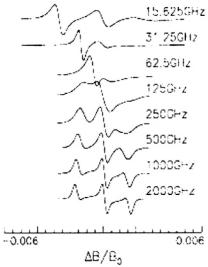
248 |
JACK H. FREED |
directionality of the cage-orienting potential could be obtained. As expected, only probes comparable to or larger than the OTP molecules experience substantial potentials, of 2-4 kT. It was possible to show that the nonlinear way in which the dynamics affects the slow-motional ESR spectra allows one to distinguish between two limiting cases. The first is that of a homogeneous liquid, but with a complex motional dynamics, (e.g. the SRLS model that was used). The second is that of an inhomogeneous liquid with a distribution of simple relaxation times (e.g. Brownian tumbling). The latter was shown to be incompatible with the 250-GHz spectra.
Figure 4. Simulation of derivative electron spin resonance spectra for a nitroxide, reorienting with a rotational diffusion coefficient  (corresponding to rotational correlation time
(corresponding to rotational correlation time  for a wide range of frequencies.
for a wide range of frequencies.
Another virtue of FIR ESR is the fact that the higher the ESR frequency, the slower the motion appears to be for a given diffusion rate. This is illustrated in Figure 4, where I show simulated spectra corresponding to the same motional rate but for different ESR frequencies, ranging from 15 GHz to 2 THz. At the low frequency end, one observes simple motionally narrowed spectra, whereas at the high frequency end, the spectra are very slow motional, almost at the rigid limit. Thus we see that the higherfrequency ESR spectra act as a faster “snapshot” of the dynamic, (Earle et al, 1993, 1997). This is because of the increased role of the g-tensor term, which is linear in magnetic field,  in the spin-Hamiltonian. As the orientation-dependent part of the spin-Hamiltonian,
in the spin-Hamiltonian. As the orientation-dependent part of the spin-Hamiltonian,  increases in magnitude with increasing frequency,
increases in magnitude with increasing frequency,  and
and  the motional-narrowing
the motional-narrowing
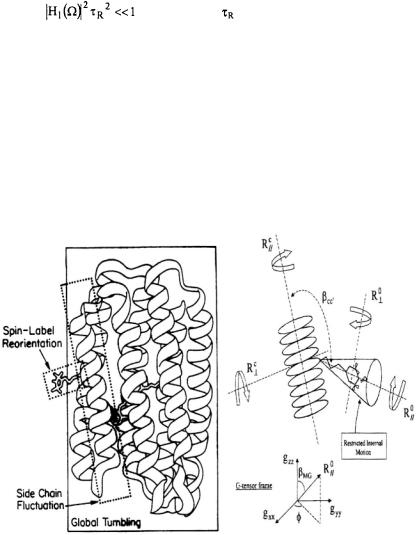
ESR AND MOLECULAR DYNAMICS |
249 |
|
condition |
fails, (where |
is the rotational relaxation time) |
and the spectra become slow motional. |
|
|
This snapshot feature suggests a multifrequency ESR approach to the study of the dynamics of complex fluids, such as glass-forming fluids and liquid crystals, as well as to the complex modes of motion of proteins and DNA, which should enable one to decompose the different modes according to their different timescales (Liang and Freed, 1999). For example, in the case of proteins, the higher frequency ESR spectra should “freeze-out” the slow overall tumbling motions, leaving only the faster internal modes of motion, whereas ESR performed at lower frequencies is sensitive to the motions on a slower timescale. In glass-forming fluids, as we have seen, the faster motions consist of reorientations of probe molecules, whereas the slower motions relate to the dynamics of the solvent cage.
Figure 5. (left) Protein Dynamics of Spin-labeled Protein: There are three kind of motions, spin-label reorientation, side chain fluctuations and global tumbling. (right) The SRLS model is illustrated including relevant motional parameters (Liang and Freed, 1999; Liang et al, 2000).
The virtues of such a multifrequency approach were demonstrated in a study, using 9- and 250-GHz spectrometers, on spin-labeled mutants of the soluble protein T4 lysozyme in aqueous solution (Barnes et al, 1999). In the fast timescale of the 250-GHz ESR experiment, the overall rotation was too slow to significantly affect the spectrum, so that it could satisfactorily be
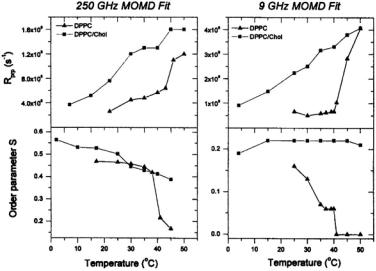
250 |
JACK H. FREED |
described by the simple MOMD (microscopic order but macroscopic disorder) model (Meirovitch et al 1984), wherein the overall motion is so slow that it corresponds to the rigid limit (see below), which yielded good spectral resolution for the internal dynamics. Then, by fixing the internal motional parameters at the values obtained from the 250-GHz data, the SRLS fits to the 9-GHz line shapes successfully yielded the rates for the global dynamics. Thus the two types of motion were separated, and spectral resolution to these motions was significantly enhanced. The SRLS model as it applies to protein dynamics is shown in Figure 5.
Figure 6. Rotational Diffusion rates and Order parameters of 16PC in lipid membranes (with and without cholesterol) from 250 GHz and 9 GHz ESR spectra obtained from their respective MOMD fits (Lou et al, 2001). At 250 GHz these reflect just the internal motions; at 9 GHz they are a composite of internal and overall motions.
This same multifrequency approach was applied to a study of the dynamic structure of model membranes using an end-chain labeled lipid, (Lou et al, 2001). It was found that the results at 250 GHz could be interpreted in terms of the MOMD model relating to just the internal dynamics and ordering of the ends of the acyl-chains, with the slower overall lipid dynamics frozen-out on the time-scale of the 250 GHz experiment, (cf Figure 6). The 9 GHz spectra, however, are affected by both the internal and overall motions, so they were analyzed in terms of the SRLS model, which explicitly includes both types of motion, using the parameters for the internal dynamics obtained from the analysis of the 250 GHz spectra. It is worth noting, however, that if the 250 GHz spectra are ignored, then the 9 GHz spectra, with their limited resolution to dynamics, could be fit to a simple
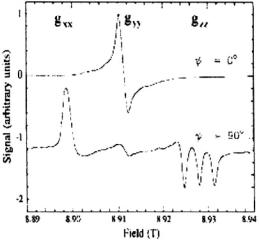
ESR AND MOLECULAR DYNAMICS |
251 |
MOMD model, but the dynamic and ordering parameters obtained must be interpreted as a composite of both the internal and overall motions, (cf Figure 6) with no obvious way of separating them.
Figure 7. 250-GHz derivative electron spin resonance spectra from cholesterol-like nitroxide in aligned PC-rich membrane with the membrane normal parallel  and perpendicular
and perpendicular  to the magnetic field, (Barnes and Freed, 1998).
to the magnetic field, (Barnes and Freed, 1998).
A striking demonstration of the excellent orientational resolution at 250 GHz in studies utilizing nitroxide spin labels was provided by a study on macroscopically aligned membranes containing a mixture of headgroups: zwitterionic phosphatidylcholine (PC) and negatively charged phosphatidylserine (PS) using the cholesterol-like spin label CSL, (Barnes and Freed, 1998). The macroscopic alignment further enhanced the orientational resolution at 250 GHz and permitted an orientation-dependent study, (cf Figure 7).
5.SPIN-ECHOES AND MOLECULAR DYNAMICS
A major weakness of cw ESR for relaxation studies is the problem of extracting reliable homogeneous line broadening from inhomogeneously broadened ESR spectra such as from nitroxide spin labels. This homogeneous line broadening is the contribution to the linewidth that arises from the motional modulation of the hyperfine and g-tensors as well as the other spin-relaxation processes. It is obscured by the inhomogeneous broadening, which is due, for example, to the unresolved proton superhyperfine interactions. This was a particular problem for our work on
